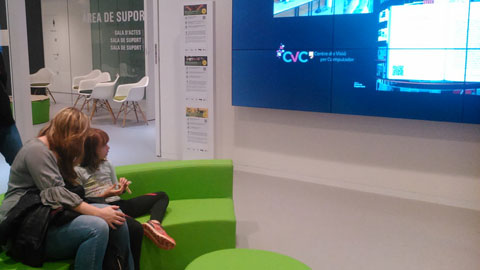Three UAB projects at the Smart City Expo World Congress

15/11/2016
From 15 to 17 November, Barcelona played host to the sixth edition of the main congress on smart cities, the Smart City Expo World Congress (SCEWC).
Konstantinos Kourkoutas, coordinator of the CORE in Smart and Sustainable Cities at the UAB, is member of the Scientific Committee, and three university projects, one from the Computer Vision Centre (CVC) and two more from the Institute for Environmental Science and Technology (ICTA-UAB), were exhibited at the congress.
The Computer Vision Centre participated as part of the stand of the town council of Sant Cugat by presenting the Library Living Lab, an innovative space located in the Volpelleres Library in Sant Cugat. This innovative space offers inhabitants a place in which research, technology and public areas can mix to offer participatory tools and added value to cultural components. The Library Living Lab was created by a consortium including the Computer Vision Centre, the Universitat Autònoma de Barcelona and the Sant Cugat Town Council, as well as the Provincial Council of Barcelona and the Association of Neighbours of Volpelleres. The initiative is also part of the European Network of Living Labs and the first living lab located within a library in Europe.
At the stand of the technological centre CIT UPC, the UAB collaorated with the Universitat Politècnica de Catalunya in the presentation of FertileCity II, a project focused on vertical urban agriculture which aims to study the integration of water flows, energy and CO2 in rooftop greenhouses. This is the continuation of a previous project aimed at creating a farming production system through the use of multidisciplinary tools such as experimental laboratory tools, at real scale, instrumentation and contrasts through numerical simulations. The second version of the project focuses on the bidirectional connection between greenhouse and building, in construction, architectonic and planning aspects. The project, coordinated by the research group Sustainability Prevention Environmental (Sostenipra) of the Universitat Autònoma de Barcelona (UAB), is also an initiative of the research group Mechanics and Nanotechnology of Engineering Materials (UPC), and the collaboration of the UPC Departments of Civil and Environmental Engineering, of Projects and Construction Engineering, and of Architectural Technology, and of the Government of Catalonia's Institute of Agrifood Research and Technology (IRTA).
ICTA-UAB was also present at the congress as a participating institute of the project Bee Happy by the Viladecans Town Council.The project consists in using bees as bioindicators of pollution in the town and surroundings. One year ago, the Viladecans Town Council place three beehives in different locations of the town with the aim of using the bees as bioindicators with which to study the impact of pollution. Two workshops were offered at the congress: one in which participants could taste different types of honey, learn about its origin, types and crystallisation. The other, offered by the ICTA-UAB Palinological Analysis Laboratory, focused on the diversity of pollen in bee related products (honey, pollen, royal jelly, propolis and wax) and its relation with its surroundings (botanical, geographical, meteorological and climate, aerobiological and anthropological aspects). Visitors were shown how to differ between pollen pellets and what bees do with these pellets.
The Smart City Expo World Congress 2016 includes over 600 guest cities, 576 exhibiting firms and 412 speakers, and it is estimated that some 14,000 people will be visiting the congress.